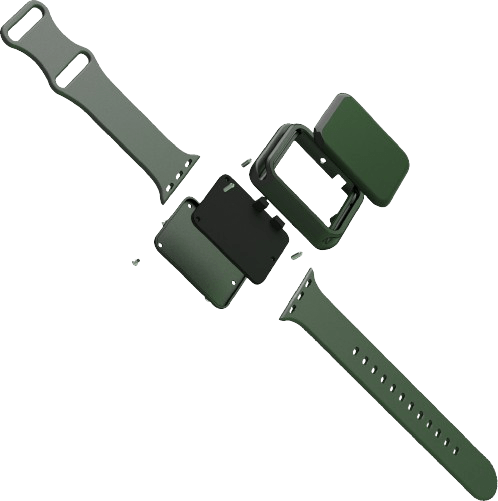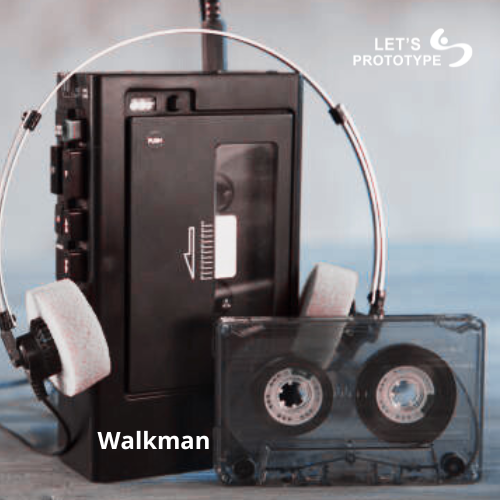We want to bring your ideas to life
CATALOG OF
PROTOTYPES
You can now access over 30 examples of prototypes designed and manufactured in our lab

I am aware of the time you dedicate to finding sources of inspiration to create a product for sale. Many entrepreneurs and inventors make the decision to pursue their financial freedom through a business model based on the sale of a new product.
In these days, I have been dedicated to reading the best articles and opinions on the internet about optimal methods to identify or create new products for sale. The truth is that I was unpleasantly surprised, as in most cases, the 'experts' agree that the most important thing is to be able to create a new need in the market.
Inventors, entrepreneurs from our Let's Prototype family. There is nothing further from the truth.
Let’s think about truly disruptive technologies that allow us to define whether their inventors created the “new need” or, on the contrary, discovered new business opportunities to design and create a new product to address these discovered needs.
In other words:
As the great Henry Ford once said: “If I had asked people what they wanted, they would have said faster horses.”
Appealing to your common sense, you will agree that Mr. Ford did not create a new need in the market to invent the first motor vehicle; the need already existed: users wanted and needed to move faster from one point to another.
Ford understood this need and opened his eyes and mind to design and manufacture a new product.
Another clear example of innovation can be seen in the case of the famous Apple iPods that took the world by storm. You may not remember it, so I’ll leave you an image to jog your memory 🙂

Do you believe that Mr. Jobs created a new market need to succeed with his new product in the market?
Absolutely NOT
Users already had and expressed the following needs through their behavior:
Let’s remember that before the iPod was invented, we had portable radios with headphones that allowed us to listen to content while on the move, but without the ability to choose what we really wanted to hear.
To give us more freedom, inventions like the famous Walkman appeared, allowing us to listen to our own music, albeit with a limited cassette in time and dimensions that made it cumbersome to carry too many options. Battery autonomy was another of the drawbacks or challenges to overcome. This product won our hearts so much that there are still replicas of its original shapes that are successfully marketed today. View product on Amazon
In order to provide us with more freedom, the Discman emerged, a device that became a part of our lives, with better battery autonomy and greater freedom to choose our music, thanks to the capacity of CDs. They became an inseparable part of certain generations. So much so that even today, almost appealing to the emotions of those who enjoyed them, they continue to be sold on platforms.
Seriously, do you still believe that Mr. Jobs created the need in order to create a new product?
The iPod, as an innovative invention, was a true revolution. Its ergonomic and compact design made it easy to use and carry, and its ability to play mp3 files multiplied the number of songs we could have on our devices. For the first time, we could choose any song from the cloud and purchase it whenever and wherever we wanted; we could connect the device to any amplifier and take our favorite music with us everywhere.
No more and no less than the same needs they had seen before; Andreas Pavel (inventor of the Walkman) and the designers of new technological products from Sony, who are credited with the creation of the Discman.
Jobs combined the most up-to-date ingredients of technology to address a need that was more than evident in the market in a different way.
Therefore, inventors, entrepreneurs: accept the reality that you will NOT be able to create a new need in the market to embark on your venture. Your mission is to identify market needs, and then design and manufacture new products to sell.
The theory or methods for creating new needs do not work; it is unrealistic and a flawed way to approach the strategy for creating a new product to sell..
Other very significant results in my online search for identifying useful methods to create a product to sell, referred to the numerous tools for comparing products and their sales trends through Amazon, AliExpress, and other leading marketplaces or platforms in product sales.
The promotion of these tools is accompanied by hundreds of options to train in their use and learn how to make decisions about product selection that, according to their creators, will lead you to success.
In my humble opinion, training is very useful, and information and data are even more so. Therefore, with these experts teaching us to identify and use tools to compare the best-selling products on Amazon, I agree 50%.
Allow me to explain.
The analysis of the sales trend of a product, its evolution, alternatives, and leading brands in sales is crucial information when making a decision to choose a product to sell.
But remember, it's not the same to choose a product to sell that is already being manufactured in China, as it is to create a new product to sell.
Appealing once again to common sense, let's evaluate the advantages and disadvantages of copying or creating a new product.
Copying a product to sell | Creating a product to sell | |
Definition | Product Selection and Comparison Process for Selling, Based on Historical Data from Online Selling Platforms Such as Amazon or AliExpress | Design and Manufacturing of a Novel Product for Sale. The Process is Defined by Identifying Unmet or Overly Saturated Needs. |
Exclusivity | Non-existent. It is manufactured in large industrial networks. While the brand is protected, the product itself is not. Anyone can alter the brand and appearance to sell it. | Whether it is a completely new product or an improvement on an existing product that adds additional functional value, it may be possible to protect it with patents or similar methods for up to 20 years. |
Useful Lifespan | Limited. The business lasts as long as the product trend in the market. In the case of being an essential product, it will be conditioned by price advantages and concessions with customers. | The product can be exclusively marketed by the inventor or companies with agreements, if it becomes protected by patents. These are often products that have a slower initial launch but greater future potential |
Profit and Prices | Prices are conditioned by competitive behavior. It's not possible to make significant differences on product selling platforms. | There is greater freedom in setting prices due to the exclusivity enjoyed through the attained legal protection. |
Position | Brand positioning is limited to products already common in the market. It's very difficult for the market to identify the brand with distinct traits | It's possible to associate the brand with innovation across various products or innovative products within the same sector. The advantages of the designed product will be linked to the brand as competitive advantages. |
Channel Dependency | These are products that are born with well-defined sales channels. Trends are studied from where their selection is made | These are innovative products or products with functional differences that represent advantages. This characteristic allows it to be sold exclusively through various channels, both owned and third-party stores. This is even more true if the product is patented. |
Business Model | Los modelos posibles son: comprar un producto para vender, o fabricar un producto con una marca propia para vender. | Creating a product to sell directly on platforms. Selling a product patent. Selling exploitation rights of a patent. |
We want to bring your ideas to life
You can now access over 30 examples of prototypes designed and manufactured in our lab

We always talk about finding unmet needs in the market to come up with and create a new product to sell. The truth is, to discover those points of dissatisfaction, the product selling platforms themselves are a great source of information.
According to our experience as a product design company, invention factory, modifying products, and collaborating with patent attorneys, we identify some ways or methods that can help us identify business opportunities.
It is one of the most common opportunities for product improvement among the individual inventors we have worked with. In most cases, they start by comparing the best-selling products on Amazon, analyzing competing products and the brands that stand out the most in the markets.
Once the trends have been identified and the sales data of the product has been studied, a qualitative analysis of customer opinions about these products is conducted on the main product sales platforms.
The most common complaints are identified, and the causes are studied. This type of analysis often leads to the product design process and manufacturing a functional prototype that includes substantial improvements to address the main unfavorable opinions. In turn, these improvements become new utility patents, providing exclusive protection to the inventor for 20 years, design registrations to protect the aesthetic modifications of the product, and the activation of new business models, such as patent sales or negotiations with interested parties regarding the exploitation of patents.
Based on the same quantitative analysis and subsequently qualitative analysis of the growth product trends in demand on the main platforms, the aim is to identify complaints or dissatisfaction regarding price. Price dissatisfaction often arises because the user feels that their problem, need, or aspiration to be resolved is not severe or relevant enough to justify the amount associated with the product price. In this case, inventors, rather than transforming a product to add improvements, focus on redesigning a product to exclude functionalities, simplifying the product, and turning it into a specific solution for the concrete problem that customers value. Inventors often fall into what we have colloquially termed internally as the “POYAQUE” theory 🙂 “Since we are at it, let’s add a feature, since we are at it, let’s add another feature”...
This type of behavior in the product creation process can be counterproductive, and if not corrected, it will hit the market as an uncompetitive product, representing a good opportunity for other entrepreneurs or inventors in the processes of creating a product to sell. In summary, when dissatisfaction arises from excess features offered by a product, the goal is to simplify and iterate on the way the main problem is addressed to arrive at
The democratization or popularization of new products in the market often represents an opportunity for design and creation of complementary new products. Complementary products are those that facilitate the use of a specific product. In their value proposition, they often convey greater ergonomics in use, protection
A clear example of innovative products that arise from other technologies or products that achieve success is mobile phone cases and their accessories.
At Let´s Prototype, we manufacture an average of 10 innovative products for mobile phones, ideas from individual inventors who are clear about the need to differentiate themselves, register new designs, and launch their own products to the market.
To cite another example of a complementary invention, the popularization of electric vehicles has allowed some inventors to devise and patent solutions to prevent failures in their charging cables, while also making their deployment and retrieval more convenient. Prototypes that have been designed and manufactured in our invention manufacturing lab. Similarly, other inventors launched a product capable of locking and unlocking designated charging spaces for these vehicles, preventing fraudulent parking in them.
You don't have to be a genius to create an innovative product and sell it in the market.
Far from needing incalculable technological skills, the primary tool for successfully launching a product to the market is observation. Therefore, instead of seeing barriers in the process of designing and creating a new product, you should train your skills to study user behavior and thus draw inspiration from product improvement options that, in turn, represent a clear business opportunity.
Secondly, I am sure that by now you are clear that if you want to successfully sell a product in the market, it’s not about spending time trying to sell a product without investing. While the path of creating a product to sell may be longer and more costly than copying a product to sell it on Amazon, in the long run, it
The time to bring your ideas to life is now. We accompany you throughout the entire process: from idea to product.
San Juan Ingenieros, S. L, is the owner of the domain www.letsprototype.com, and in accordance with the General Data Protection Regulation (EU 1679/2016), we will process your data exclusively to handle your information request. You have the right to rectify or request the deletion of your data at any time via hello@letsprototype.com.

Industrial design and innovative product development company | Specialists in manufacturing working prototypes.